Viable Agri-Food Supply Chains: Survival Through Systemic Adaptations
Abstract
1. Introduction
2. Literature Review
2.1. Agri-Food Supply Chains (ASCs) Under Normal Conditions
2.1.1. ASC Definition
2.1.2. ASC Classifications
2.2. Agri-Food Supply Chains Under Disruptive Conditions
2.2.1. Disruptions
2.2.2. Performance Dynamics During Disruptions
- (I)
- Robustness/resistance (absorbing routine disturbances);
- (II)
- Shock and survival (performance drop then stabilisation at a survivable level);
- (III)
- Resilience (recovery to an acceptable level within a recovery time);
- (IV)
- Adaptation (learning and structural change, potentially exceeding pre-disruption performance or prompting re-engineering if adaptation fails).
2.2.3. COVID-19 as a Super Disruption
2.2.4. Adaptations During COVID-19: Mapping ASC Responses to Viability Strategies
- (a)
- Insights from the manufacturing and services sectors
- (b)
- Adaptations in ASCs
2.3. Emergence of Supply Chain Viability
2.3.1. Definition of Supply Chain Viability
2.3.2. Supply Chain Viability in Relation to Pre-2020 Strategic Paradigms
2.4. Agri-Food Supply Chain Viability
2.4.1. Role of Digital Inter-Connection in ASCs for Viability
2.4.2. Spatial Ecologies Within the ASC Ecosystem
2.5. Summary and Research Gaps
3. Methodology
3.1. Research Questions
3.2. Research Approach
3.3. Research Context
3.3.1. Organisation of Key ASC Channels in Sri Lanka
- Production: Farmers operate across dry/ wet/ intermediate agro-climatic zones and by elevation (up-country vs. low-country), rotating crops with Yala (dry) and Maha (wet) monsoon seasons, ensuring a year-round supply. The system is climate responsive but labour intensive with limited mechanisation.
- Logistics: The logistics segment relies on intermediaries, including collectors, wholesalers, distributors, traders, and transporters, who aggregate, store, and redistribute produce across the country. Key nodes in this network include collection centres, government-run Dedicated Economic Centres (DECs), farmers’ markets (known as “pola” in the local language), public retail markets, roadside vendors, and supermarket collection hubs. Table 5 outlines the functions of each node.
- Consumption: Demand is concentrated in the Western Province, particularly in Colombo, which has the country’s highest population density and income levels. Yet it produces very little food, relying heavily on inflows from rural regions. This structural imbalance, high demand but minimal production, made Colombo especially vulnerable to severe supply disruptions during COVID-19.
3.3.2. Common Spatial Ecologies
3.3.3. Long-Term Disruption Timeline and Interventions
3.4. Sampling and Participants
- Production: Farmers (5)
- Logistics/Retail: Wholesalers and logistics providers (2), retailers (6)
- Consumption: Consumers (28—representing a minimum of three per group from each spatial ecology [90])
- Enablers: Agri-tech entrepreneurs (3; technological subsystem), agriculture policymakers (2; social/governance subsystem)
3.5. Data Collection
- Explain the ways that you purchased fresh agri-produce before, during, and after the pandemic. Explain the reasons for selecting each of the channels.
- Have you changed your consumption patterns over time? And how? And why?
- Do you/did you use any technological applications or social media to purchase fresh agri-food? How did it help you overcome the issues?
3.6. Data Analysis
- First, open coding was conducted to identify adaptations, decision rationales, and enabling factors across different ASC segments.
- Second, axial coding was performed to group related codes into broader categories such as channel type, spatial ecology, and enabler.
- Finally, selective coding was employed to integrate these categories into a coherent account that explains channel formation, transitions, and enablers under disruption.
- ASC Channel Classification (M1–M4): Developed from the literature and observed adaptations to typify emergent channels (Refer RQ1 Analysis).
- Cost–Availability–Quality (CAQ) Framework: This research adapted cost, availability, and quality [8] factors to identify and develop a framework from consumers’ perspectives on agri-food during long-term disruptions, explaining channel switching during these disruptions (Refer RQ2 Analysis).
- Behaviour-Over-Time (BOT) Graphs: BOT graphs (reference modes) were used to track the shift in popularity of ASC channels across phases (pre-, during-, and post-disruption). They capture recurring behavioural patterns over time, offering systematic insights for decision-making [93] (Refer RQ2 Analysis).
- Viability Adaptation Strategies: Ivanov [42] proposed four adaptation strategies for the manufacturing and production sector during a long-term disruption situation. Those strategies are intertwined, including scalability, substitution, and repurposing. This research utilised these four strategies and empirically validated them (Refer to RQ3 Analysis).
4. Results and Discussion
4.1. RQ1-Emergent ASC Modes
- Home gardening: Many consumers, particularly those with access to land and the necessary resources, began cultivating their own food. Home gardening quickly became a direct means of securing food supplies during the disruption.
- Food Sharing: Households with surplus produce, particularly home gardeners, engaged in sharing or exchanging food within their communities. This practice created informal safety nets, enabling access to agri-food in the absence of a reliable formal supply.
- Formal online channels: Beyond the pre-existing group of e-commerce users, a significant number of consumers shifted to online platforms as their primary source of agri-food. In response to rising demand, several new e-commerce platforms emerged to facilitate food distribution.
- Informal online channels: Local farmers and small-scale sellers who could not access established e-commerce platforms, as well as established retailers, turned to informal online methods, such as WhatsApp groups, Facebook groups, other social media channels, and phone calls, to reach consumers.
- Mobile sellers: Although mobile vendors had a limited role before the pandemic, their importance grew substantially during this period. With restrictions limiting consumer mobility and regulations eased for vendors, mobile sellers emerged as a widely used supply channel.
- Roadside selling: This was a common way of selling fresh food when the traditional markets were closed. Additionally, mobile vendors also sold along the roadside during that time.
4.2. RQ2—Spatial Ecology Patterns, Channel Choice, and Transitions
4.2.1. Rural
4.2.2. Urban
4.2.3. Semi-Urban
4.2.4. Key Insights on Channel Behaviours
- Rural recovery was production and community-driven, maintaining all three CAQ factors through self-sufficiency.
- Urban recovery was digitally driven, focusing on Availability through new intermediation models (M4 digital platforms, M3 mobile sellers).
- Semi-urban recovery emerged as a hybrid, blending self-production, local shops, and selective digital adoption.
4.2.5. Rationale and Validation of Cost–Availability–Quality Framework
- Cost is linked to the right price, reflecting production, logistics, and transaction efficiency that minimise supply chain costs.
- Availability corresponds to right product, right place, right time, and right quantity, representing responsiveness and flexibility that ensure timely and sufficient supply to meet consumer demand and prevent shortages.
- Quality aligns with right product, right condition, and right customer, encompassing product quality (appearance, taste, shelf life) and process quality (traceability, storage, transport, and working conditions), supported by transparency and food safety standards.
4.3. RQ3—System-Level Enablers of Channel Adaptation
4.3.1. Systemic Enablers of ASC Adaptations
- Governance and Policy Coordination (Macro-level)
- Digital Technologies and Cross-Sector Innovation (Meso-level)
- Private Sector, Community, and Social Capital (Meso-level)
- Behavioural and Market Adaptations (Micro-level)
- Environmental and Spatial–Ecological Conditions (Contextual level):
4.3.2. ASC Viability Through a Multi-Level Enabling System
5. Conclusions
- Urban systems relied heavily on digitalised intermediaries (M4 online) and mobile sellers (M3) yet faced higher food insecurity due to space constraints and dependence on supermarkets.
- Semi-urban systems adopted hybrid portfolios—expanding home gardening (M1), strengthening sharing (M2), and combining physical and digital linkages (M3 and M4) supported by proximity to producers.
- Rural systems, the most self-sufficient, scaled up M1 and M2 and channelled surplus through M3 local/mobile networks, with M4 playing a minor role.
Author Contributions
Funding
Data Availability Statement
Acknowledgments
Conflicts of Interest
Abbreviations
| AI | Artificial Intelligence |
| ASC | Agri-food Supply Chain |
| BOT | Behaviour Over Time |
| CAQ | Cost–Availability–Quality |
| COVID-19 | Coronavirus Disease 2019 |
| DEC | Dedicated Economic Centre |
| FAO | Food and Agriculture Organization (of the United Nations) |
| FGD | Focus Group Discussion |
| IoT | Internet of Things |
| LMICs | Low- and Middle-Income Countries |
| M1–M4 | ASC Four Modes (M1: Prosumer, M2: Community Sharing, M3: Direct Farmer–Consumer, M4: Intermediary-Based Channel) |
| MVPS | Maximum Variation Purposive Sampling |
| OECD | Organisation for Economic Co-operation and Development |
| PDS | Public Distribution System |
| RQ | Research Question |
| SCM | Supply Chain Management |
| SDGs | Sustainable Development Goals |
| US | United States |
| VSC | Viable Supply Chain |
Appendix A
Appendix A.1. Participant Categories
| Stakeholder Group | Type | Number of Participants | Representation | Code * | Geographic Locations and Other Details (U-Urban, SU-Semi-Urban, R-Rural) |
|---|---|---|---|---|---|
| Farmers | Interviews | 5 | Rural areas | F1 | 1. Ambewela, Nuwara Eliya (Extent: 10 Acre; Crops: Potato, Carrot, Leeks, Cabbage) |
| F2 | 2. Paranagama, Welimada (Crops: Potato, Carrot, Beans, Beet Root, Radish, Rice) | ||||
| F3 | 3. Ampara (Type: Greenhouse farming; Crops: Tomato, Bell pepper, Red Cabbage) | ||||
| F4 | 4. Bandarawela (Type: Polytunnel farming; Crops: Cucumber, Pepper) | ||||
| F5 | 5. Meerigama (Extent: 20 Acre; Crops: Pineapple, Banana, Coconut) | ||||
| Wholesalers and Logistics service providers | Interviews | 2 | Rural areas (Economic Centre operators—an Economic Centre is a dedicated wholesale marketplace) | W1 | 1. Meegoda Economic Centre Operator (selling vegetables Wholesale only)—handle distribution as well |
| W2 | 2. Meegoda Economic Centre Operator (Selling vegetables 80% and 20% groceries) | ||||
| Retailers | Interviews | 6 | Supermarkets—3 (Urban) (2 with national level experience) | REU1 | 1. U-Moratuwa—Outlet Operations, Manager (Supermarket chain A) |
| REU2 | 2. U-Colombo—Island-wide Operations, Senior Manager (Supermarket chain A) | ||||
| REU3 | 3. U-Matara, Colombo and Island-wide Operations, Senior Manager (Supermarket chain B) | ||||
| Farmers’ market—1 (Rural) | RER4 | 4. R-Meerigama local farmers’ market | |||
| Vegetable shops—2 (Semi-urban) | RESU5 | 5. SU-Walgama (small scale shop) | |||
| RESU6 | 6. SU-Walgama (large scale shop) | ||||
| Consumers | Interviews | 10 | Urban—4 (1 with national level experience) | CU1 | 1. Colombo, Western Province |
| CU2 | 2. Kiribathgoda, Western Province (has experience with working with farmers across the country) | ||||
| CU3 | 3. Dalugama, Kelaniya, Western Province | ||||
| CU4 | 4. Colombo 10, Western Province | ||||
| Rural—3 | CR1 | 5. Galkanda, Ampara District, Eastern Province (Farming family) | |||
| CR2 | 6. Kurunegala District, North-western Province | ||||
| CR3 | 7. Udalamatta, Galle District, Southern Province | ||||
| Semi-urban—3 | CSU1 | 8. Galle District, Southern Province | |||
| CSU2 | 9. Matara District, Southern Province | ||||
| CSU3 | 10. Panadura, Western Province | ||||
| FGD | 18 | Urban—2 FDGs, 3 consumers each | CUFGD1 | 1. Colombo-6, Western Province 2. Colombo-10, Western Province 3. Colombo-5, Western Province | |
| CUFGD2 | 4. Gampola, Central Province 5. Gelioya, Central Province 6. Mawanella, Sabaragamuwa Province | ||||
| Rural—2 FDGs, 3 consumers each | CRFGD1 | 7. Ampara- Kethsirigama (Farming family and sell via a Facebook page) 8. Ampara- Jayewardenepura (Farming family) 9. Ampara-Uhana (Farming family); Eastern Province | |||
| CRFGD2 | 10. Bandarawela (Farming family), Uva Province 11. Bandarawela (Farming family), Uva Province 12. Buttala, Uva Province | ||||
| Semi-urban—2 FDGs, 3 consumers each | CSUFGD1 | 13. Badulla, Uva Province 14. Ja-ela, Western Province 15. Piliyandala, Western Province | |||
| CSUFGD2 | 16. Matara, Southern Province 17. Kamburugamuwa, Southern Province 18. Bandaragama, Western Province | ||||
| Agri-tech entrepreneurs | Interviews | 3 | E-commerce—2 | ATE 1 | 1. A tech entrepreneur, formerly in the ride-share industry, who has launched a new web- and social media-based business. |
| ATE2 | 2. The CEO of a finance company in the farmer micro-financing sector, testing a proof-of-concept web-based business model. | ||||
| Home gardening Mobile app—1 | ATE3 | 3. An academic who also leads a project developing a mobile app that provides knowledge and guidance to home gardeners. | |||
| Agriculture policymakers | Interviews | 2 | National level | PM1 | 1. A food security policymaker at the Ministry of Agriculture, who also holds an academic role. |
| PM2 | 2. The Project Coordinator for the Agriculture Modernisation Project at the Ministry of Agriculture. | ||||
| Total | 46 | ||||
Appendix A.2. Spatial Distribution of the Participants Within the Map of Sri Lanka

References
- Aday, S.; Aday, M.S. Impact of COVID-19 on the food supply chain. Food Qual. Saf. 2020, 4, 167–180. [Google Scholar] [CrossRef]
- Organisation for Economic Co-operation and Development. Food Supply Chains and COVID-19: Impacts and Policy Lessons; Organisation for Economic Co-operation and Development: Paris, France, 2020. [Google Scholar]
- Food and Agriculture Organization of the United Nations; International Fund for Agricultural Development; United Nations Children’s Fund; World Food Programme; World Health Organization. The state of Food Security and Nutrition in the World 2021; Food and Agriculture Organization of the United Nations: Rome, Italy, 2021. [Google Scholar]
- Wood, J.; Wong, C.; Paturi, S. Vertical farming: An assessment of Singapore city. eTropic Electron. J. Stud. Trop. 2020, 19, 228–248. [Google Scholar] [CrossRef]
- Hossain, S.T. Impacts of COVID-19 on the agri-food sector: Food security policies of Asian productivity organization members. J. Agric. Sci. Sri Lanka 2020, 15, 116–132. [Google Scholar] [CrossRef]
- Kamiyama, C.; Hori, K.; Matsui, T.; Pretty, J.; Saito, O. Longitudinal analysis of home food production and food sharing behavior in Japan: Multiple benefits of local food systems and the recent impact of the COVID-19 pandemic. Sustain. Sci. 2023, 18, 2277–2291. [Google Scholar] [CrossRef]
- Sgroi, F.; Marino, G. Environmental and digital innovation in food: The role of digital food hubs in the creation of sustainable local agri-food systems. Sci. Total Environ. 2022, 810, 152257. [Google Scholar] [CrossRef] [PubMed]
- Vidanagamachchi, K.; Ginige, A. Consumer-centred viable agri-food supply chain ecosystem and potential digital enhancements: An exploratory study. In Proceedings of the Australasian Conference on Information Systems 2023, Wellington, New Zealand, 5–8 December 2023. [Google Scholar]
- Vidanagamachchi, K.; Ginige, A.; Nakandala, D. Digitally enabling viable agri-food supply chain ecosystems for climate change adaptations. Amplify 2024, 37, 44–53. [Google Scholar]
- Ivanov, D. Viable supply chain model: Integrating agility, resilience and sustainability perspectives-lessons from and thinking beyond the COVID-19 pandemic. Ann. Oper. Res. 2022, 319, 1411–1431. [Google Scholar] [CrossRef]
- Ivanov, D. Predicting the impacts of epidemic outbreaks on global supply chains: A simulation-based analysis on the coronavirus outbreak (COVID-19/SARS-CoV-2) case. Transp Res E Logist Transp Rev 2020, 136, 101922. [Google Scholar] [CrossRef]
- Chervenkova, T.; Ivanov, D. Adaptation strategies for building supply chain viability: A case study analysis of the global automotive industry re-purposing during the COVID-19 pandemic. Transp. Res. Part E Logist. Transp. Rev. 2023, 177, 103249. [Google Scholar] [CrossRef]
- Ali, E.; Gossaye, W. The effects of supply chain viability on supply chain performance and marketing performance in case of large manufacturing firm in Ethiopia. Braz. J. Oper. Prod. Manag. 2023, 20, 1535. [Google Scholar] [CrossRef]
- Schleifenheimer, M.; Ivanov, D. Pharmaceutical retail supply chain responses to the COVID-19 pandemic. Ann. Oper. Res. 2024, 1–26. [Google Scholar] [CrossRef]
- Ivanov, D. The Industry 5.0 framework: Viability-based integration of the resilience, sustainability, and human-centricity perspectives. Int. J. Prod. Res. 2023, 61, 1683–1695. [Google Scholar] [CrossRef]
- Balezentis, T.; Zickiene, A.; Volkov, A.; Streimikiene, D.; Morkunas, M.; Dabkiene, V.; Ribasauskiene, E. Measures for the viable agri-food supply chains: A multi-criteria approach. J. Bus. Res. 2023, 155, 113417. [Google Scholar] [CrossRef]
- Chopra, V.S.; Meindl, P. Supply Chain Management: Strategy, Planning, and Operation; Prentice Hall: Hoboken, NJ, USA, 2013. [Google Scholar]
- Schrobback, P.; Rolfe, J.; Star, M. An agri-food supply chain assessment framework: Application to Queensland case studies. Australas. J. Reg. Stud. 2020, 26, 379–410. [Google Scholar]
- van der Vorst, J.; Tromp, S.; Zee, D.J. Simulation modelling for food supply chain redesign; Integrated decision making on product quality, sustainability and logistics. Int. J. Prod. Res. 2009, 47, 6611–6631. [Google Scholar] [CrossRef]
- Nakandala, D.; Lau, H.C.W. Innovative adoption of hybrid supply chain strategies in urban local fresh food supply chain. Supply Chain Manag. Int. J. 2019, 24, 241–255. [Google Scholar] [CrossRef]
- Aramyan, L.; Ondersteijn, C.; Kooten, O.; Lansink, A.O. Performance indicators in agri-food production chains. In Quantifying the Agri-Food Supply Chain; Ondersteijn, C.J.M., Wijnands, J.H.M., Huirne, R.B.M., Kooten, O.v., Eds.; Springer Nature: Cham, Switzerland, 2006; pp. 47–64. [Google Scholar]
- Mehrabi, S.; Perez-Mesa, J.C.; Giagnocavo, C. The role of consumer-citizens and connectedness to nature in the sustainable transition to agroecological food systems: The mediation of innovative business models and a multi-level perspective. Agriculture 2022, 12, 203. [Google Scholar] [CrossRef]
- Awazi, N.P.; Tchamba, M.N.; Temgoua, L.F.; Avana, M.-L.T.; Shidiki, A.A.; Forje, G.W.; Nfornkah, B.N. Climate-smart and agro-ecological farming systems of smallholder farmers. In Environment and Climate-Smart Food Production; Galanakis, C.M., Ed.; Springer International Publishing: Berlin, Germany, 2022; pp. 31–72. [Google Scholar]
- Ilbery, B.; Maye, D. Food supply chains and sustainability: Evidence from specialist food producers in the Scottish/English borders. Land Use Policy 2005, 22, 331–344. [Google Scholar] [CrossRef]
- Marsden, T.; Banks, J.; Bristow, G. Food supply chain approaches: Exploring their role in rural development. Sociol. Rural. 2000, 40, 424–438. [Google Scholar] [CrossRef]
- High Level Panel of Experts. Food Security and Nutrition: Building a Global Narrative Towards 2030; HLPE Report #15; Food and Agriculture Organization of the United Nations: Rome, Italy, 2020. [Google Scholar]
- Savary, S.; Akter, S.; Almekinders, C.; Harris, J.; Korsten, L.; Rötter, R.; Waddington, S.; Watson, D. Mapping disruption and resilience mechanisms in food systems. Food Secur. 2020, 12, 695–717. [Google Scholar] [CrossRef]
- El-Khazen, E.; Rose, C. Routes to Disruption-Supply Chain Sabotage and Israel’s War on Gaza. Available online: https://merip.org/2024/07/routes-to-disruption-supply-chain-sabotage-and-israels-war-on-gaza/ (accessed on 20 December 2024).
- Food and Agriculture Organization of the United Nations; International Food Policy Research Institute; World Food Programme. The Global Report on Food Crises 2022; World Food Programme: Rome, Italy, 2022. [Google Scholar]
- Whelan, J.; Brown, A.D.; Coller, L.; Strugnell, C.; Allender, S.; Alston, L.; Hayward, J.; Brimblecombe, J.; Bell, C. The Impact of COVID-19 on Rural Food Supply and Demand in Australia: Utilising Group Model Building to Identify Retailer and Customer Perspectives. Nutrients 2021, 13, 417. [Google Scholar] [CrossRef]
- Ivanov, D.; Sokolov, B. Adaptive Supply Chain Management; Springer Nature: London, UK, 2010; pp. 1–269. [Google Scholar]
- Wagner, S.M.; Bode, C. An empirical examination of supply chain performance along several dimensions of risk. J. Bus. Logist. 2008, 29, 307–325. [Google Scholar] [CrossRef]
- Behdani, B. Handling Disruptions in Supply Chains: An Integrated Framework and an Agent-Based Model. Ph.D. Thesis, Delft University of Technology, Delft, The Netherlands, 2013. [Google Scholar]
- Blackhurst, J.; Craighead, C.W.; Elkins, D.; Handfield, R.B. An empirically derived agenda of critical research issues for managing supply-chain disruptions. Int. J. Prod. Res. 2005, 43, 4067–4081. [Google Scholar] [CrossRef]
- Bukowski, L. Reliable, Secure and Resilient Logistics Networks: Delivering Products in a Risky Environment; Springer: Cham, Switzerland, 2019. [Google Scholar]
- Sheffi, Y.; Rice, J.B., Jr. A supply chain view of the resilient enterprise. MIT Sloan Manag. Rev. 2005, 47, 41–48. [Google Scholar]
- Ivanov, D. Two views of supply chain resilience. Int. J. Prod. Res. 2023, 62, 4031–4045. [Google Scholar] [CrossRef]
- Ivanov, D. Structural Dynamics and Resilience in Supply Chain Risk Management; Springer Nature: Cham, Switzerland, 2018. [Google Scholar]
- Barman, A.; Das, R.; De, P.K. Impact of COVID-19 in food supply chain: Disruptions and recovery strategy. Curr. Res. Behav. Sci. 2021, 2, 338–349. [Google Scholar] [CrossRef]
- Ivanov, D. Supply chain risks, disruptions, and ripple effect. In Introduction to Supply Chain Resilience: Management, Modelling, Technology; Ivanov, D., Ed.; Springer Nature: Cham, Switzerland, 2021; pp. 1–28. [Google Scholar]
- Ruel, S.; Elbaz, J.; Ivanov, D.; Das, A. Supply chain viability: Conceptualization, measurement, and nomological validation. Ann. Oper. Res. 2024, 335, 1107–1136. [Google Scholar] [CrossRef]
- Ivanov, D. Supply chain viability and the COVID-19 pandemic: A conceptual and formal generalisation of four major adaptation strategies. Int. J. Prod. Res. 2021, 59, 3535–3552. [Google Scholar] [CrossRef]
- Raj, A.; Mukherjee, A.A.; Jabbour, A.B.L.d.S.; Srivastava, S.K. Supply chain management during and post-COVID-19 pandemic: Mitigation strategies and practical lessons learned. J. Bus. Res. 2022, 142, 1125–1139. [Google Scholar] [CrossRef]
- Dey, S. Surviving major disruptions: Building supply chain resilience and visibility through rapid information flow and real-time insights at the “edge”. Sustain. Manuf. Serv. Econ. 2023, 2, 100008. [Google Scholar] [CrossRef]
- Saxena, V.; Manna, S.; Rajput, S.K.; Kumar, P.; Sharma, B.; Alsharif, M.H.; Kim, M.-K. Navigating the complexities of distributed generation: Integration, challenges, and solutions. Energy Rep. 2024, 12, 3302–3322. [Google Scholar] [CrossRef]
- Vidanagamachchi, K.; Ginige, A.; Nakandala, D. A systems thinking approach to achieve food security through agricultural market intelligence. In Proceedings of the Australasian Conference on Information Systems 2024: Digital Futures for a Sustainable Society, Canberra, Australia, 4–6 December 2024. Paper 151. [Google Scholar]
- Aziz, S.R.A.; Zain, N.H.M.; Zulkipli, N.H.N.; Azam, N.A.A. Factors influencing people’s participation in home garden project during COVID-19 pandemic: A review. Int. J. Adv. Trends Comput. Sci. Eng. 2020, 9, 184–191. [Google Scholar] [CrossRef]
- Reardon, T.; Zilberman, D. Symbiotic, resilient, and rapidly transforming food supply chains in LMICS: Supermarket and e-commerce revolutions helped by wholesale and logistics co-pivoting. In Risks in Agricultural Supply Chains; Zilberman, D., Antràs, P., Eds.; University of Chicago Press: Chicago, IL, USA, 2023; pp. 13–28. [Google Scholar]
- Kent, K.; Gale, F.; Penrose, B.; Auckland, S.; Lester, E.; Murray, S. Consumer-driven strategies towards a resilient and sustainable food system following the COVID-19 pandemic in Australia. BMC Public Health 2022, 22, 1539. [Google Scholar] [CrossRef]
- Food and Agriculture Organization of the United Nations. Making Agrifood Systems More Resilient to Shocks and Stresses; The Food and Agriculture Organization: Rome, Italy, 2021. [Google Scholar]
- Joshi, S.; Sharma, M. Digital technologies (DT) adoption in agri-food supply chains amidst COVID-19: An approach towards food security concerns in developing countries. J. Glob. Oper. Strateg. Sourc. 2022, 15, 262–282. [Google Scholar] [CrossRef]
- Karunanayaka, C.; Vidanagamachchi, K.; Wickramarachchi, R. Transforming agriculture supply chain with technology adoption-: A critical review of literature. In Proceedings of the International Conference on Industrial Engineering and Operations Management, Dubai, United Arab Emirates, 10 – 12 March 2020; pp. 1163–1170. [Google Scholar]
- Tonnang, H.E.Z.; Sokame, B.M.; Wamalwa, M.; Niassy, S.; Muriithi, B.W. System dynamics modeling for assessing the impact of COVID-19 on food supply chains: A case study of Kenya and Rwanda. Sustainability 2023, 15, 4717. [Google Scholar] [CrossRef]
- Toffler, A. The Third Wave, 1st ed.; William Morrow and Company: New York, NY, USA, 1980. [Google Scholar]
- Veen, E.J.; Dagevos, H.; Jansma, J.E. Pragmatic prosumption: Searching for food prosumers in The Netherlands. Sociol. Rural. 2021, 61, 255–277. [Google Scholar] [CrossRef]
- Jain, P.; Potdar, V. Frameworks for developing an agro-prosumer community group platform. PeerJ Comput. Sci. 2021, 7, e765. [Google Scholar] [CrossRef] [PubMed]
- Ivanov, D.; Dolgui, A. Viability of intertwined supply networks: Extending the supply chain resilience angles towards survivability. A position paper motivated by COVID-19 outbreak. Int. J. Prod. Res. 2020, 58, 2904–2915. [Google Scholar] [CrossRef]
- Ivanov, D.; Dolgui, A.; Blackhurst, J.V.; Choi, T.-M. Toward supply chain viability theory: From lessons learned through COVID-19 pandemic to viable ecosystems. Int. J. Prod. Res. 2023, 61, 2402–2415. [Google Scholar] [CrossRef]
- Wieland, A.; Wallenburg, C.M. The influence of relational competencies on supply chain resilience: A relational view. Int. J. Phys. Distrib. Logist. Manag. 2013, 43, 300–320. [Google Scholar] [CrossRef]
- Seuring, S.; Müller, M. From a literature review to a conceptual framework for sustainable supply chain management. J. Clean. Prod. 2008, 16, 1699–1710. [Google Scholar] [CrossRef]
- Kontopanou, M.; Tsoulfas, G. Promoting the concept of viability in agri-food supply chains. Int. J. Sustain. Agric. Manag. Inform. 2025, 11, 148–164. [Google Scholar] [CrossRef]
- Balezentis, T.; Zickiene, A.; Volkov, A.; Streimikiene, D.; Morkunas, M.; Dabkiene, V.; Ribasauskiene, E. Probabilistic model for assessing the effects of the disruptive events on the viability of the agri-food supply chains: The case of Lithuania. IEEE Trans. Eng. Manag. 2024, 71, 9679–9690. [Google Scholar] [CrossRef]
- Dolgui, A.; Ivanov, D.; Sokolov, B. Reconfigurable supply chain: The X-network. Int. J. Prod. Res. 2020, 58, 4138–4163. [Google Scholar] [CrossRef]
- Nyoko, A.E.L. The role of social media marketing during the COVID-19 pandemic. J. Manaj. Maranatha 2022, 21, 113–120. [Google Scholar] [CrossRef]
- Ginige, A.; Walisadeera, A.I.; Ginige, T.; Silva, L.D.; Giovanni, P.D.; Mathai, M.; Goonetillake, J.; Wikramanayake, G.; Vitiello, G.; Sebillo, M.; et al. Digital knowledge ecosystem for achieving sustainable agriculture production: A case study from Sri Lanka. In Proceedings of the International Conference on Data Science and Advanced Analytics, Montreal, QC, Canada, 17–19 October 2016; pp. 602–611. [Google Scholar]
- Njomane, L.; Telukdarie, A. Impact of COVID-19 food supply chain: Comparing the use of IoT in three South African supermarkets. Technol. Soc. 2022, 71, 102051. [Google Scholar] [CrossRef]
- Agrawal, S.; Agrawal, R.; Kumar, A.; Luthra, S.; Garza-Reyes, J.A. Can industry 5.0 technologies overcome supply chain disruptions?—A perspective study on pandemics, war, and climate change issues. Oper. Manag. Res. 2023, 17, 453–468. [Google Scholar] [CrossRef]
- Villar, A.; Paladini, S.; Buckley, O. Towards supply chain 5.0: Redesigning supply chains as resilient, sustainable, and human-centric systems in a post-pandemic world. Oper. Res. Forum 2023, 4. [Google Scholar] [CrossRef]
- 69. Hofmann, E.; Langner, D. The Rise of Supply Chain Viability Digital Solutions as a Boosting Role; University of St.Gallen: Gallen, Switzerland, 2020; pp. 1–14. [Google Scholar]
- Vidanagamachchi, K.; Ginige, A.; Nakandala, D. Spatial ecologies in viable agri-food supply chains: Insights from iceberg model and causality analysis. In Proceedings of the Australasian Conference on Information Systems 2024: Digital Futures for a Sustainable Society, Canberra, Australia, 4–6 December 2024. Paper 160. [Google Scholar]
- Britto, K.K.A.N.; Sheresha, H.A.S.K.N. Creating opportunities in a challenging environment: Experiential crisis learning behaviour of tourism SMEs in Sri Lanka. Cogent Bus. Manag. 2024, 11, 2314803. [Google Scholar] [CrossRef]
- Rannan-Eliya, R.P.; Ghaffoor, A.; Amarasinghe, S.; Nirmani, M.D.; Wijemunige, N.; Perera, S.; Samarage, S.; Dalpatadu, K.C.S.; Wisidagama, N.; Fonseka, S. Sri Lanka’s COVID-19 response and maintaining health services: Implications for future pandemics. BMJ Glob. Health 2024, 8, 1–16. [Google Scholar] [CrossRef]
- Samarakoon, L.P. What broke the pearl of the Indian ocean? The causes of the Sri Lankan economic crisis and its policy implications. J. Financ. Stab. 2024, 70, 101213. [Google Scholar] [CrossRef]
- Chandrasiri, M.K.D.C.K.; Dharmapriya, U.S.S.; Kulatunga, A.K.; Ratnayake, R.M.R.N.K.; Wasala, W.M.C.B.; Weerakkody, W.A.P. Supply chain reconfiguration as an option to mitigate post harvest losses and GHGs: Simulating a case study from banana supply chain in Sri Lanka. In Proceedings of the 18th Global Conference on Sustainable Manufacturing, Berlin, Germany, 5–7 October 2022; pp. 1044–1052. [Google Scholar]
- Gunarathna, R.T.; Bandara, Y.M. Post harvest losses and the role of intermediaries in the vegetable supply chain. In Proceedings of the Moratuwa Engineering Research Conference (MERCon), Moratuwa, Sri Lanka, 28–30 July 2020; pp. 378–383. [Google Scholar]
- Sampath, G.M.G.; Jayantha, K.; Peiris, D.; Rajapaksha, R.; Abeykoon, A. Classifying outdoor recreation opportunities in urban and semi-urban areas: A case of Sri Lanka. Int. J. Sci. Res. Publ. 2020, 10, 714–730. [Google Scholar] [CrossRef]
- Weeraratne, B. Re-defining urban areas in Sri Lanka. In Working Paper No. 23; Institute of Policy Studies of Sri Lanka: Colombo, Sri Lanka, 2016. [Google Scholar]
- Wu, J. Urban ecology and sustainability: The state-of-the-science and future directions. Landsc. Urban Plan. 2014, 125, 209–221. [Google Scholar] [CrossRef]
- Ribeiro, C.; Viana, C.M.; Girão, I.; Figueiredo, E.; Rocha, J. The spatiotemporal links between urban and rural regions through the sale and consumption of agri-food products. Sustainability 2023, 15, 12038. [Google Scholar] [CrossRef]
- Zhao, T.; Cheng, Y.; Fan, Y.; Fan, X. Functional tradeoffs and feature recognition of rural production–living–ecological spaces. Land 2022, 11, 1103. [Google Scholar] [CrossRef]
- Čustović, H.; Kovačević, Z.; Tvica, M. Rural Ecology; University of Sarajevo: Sarajevo, Bosnia and Herzegovina, 2013. [Google Scholar]
- Thornton, L.E.; Crawford, D.A.; Lamb, K.E.; Ball, K. Where do people purchase food? A novel approach to investigating food purchasing locations. Int. J. Health Geogr. 2017, 16, 1–13. [Google Scholar] [CrossRef] [PubMed]
- Ratnamalala, A.U.B. Effectiveness of e-commerce websites as a means of transforming traditional grassroots businesses in Sri Lanka. GARI Int. J. Multidiscip. Res. 2019, 5, 27–44. [Google Scholar]
- Damruwan, M.V.T.; Jayasinghe, S.; Wijayanayaka, W.M.J.I. Customer satisfaction analysis based on delivery logistics factors in Sri Lankan e-commerce. In Proceedings of the International Research Conference on Smart Computing and Systems Engineering, Kelaniya, Sri Lanka, 29–29 June 2023; pp. 1–9. [Google Scholar]
- Fernando, W.M.; Thibbotuwawa, A.; Ratnayake, R.M.C.; Perera, H.N. Digitalizing smallholder farmer agri-food supply chains: A case study from a developing economy. In Proceedings of the International Conference on Advances in Production Management Systems, Cham, Switzerland, 8–11 September 2024; pp. 164–176. [Google Scholar]
- Jayalath, M.M.; Perera, H.N.; Ratnayake, R.M.C.; Thibbotuwawa, A. Towards digital transformation of vegetable supply chains in developing economies. In Proceedings of the 2024 Joint International Conference on Digital Arts, Media and Technology with ECTI Northern Section Conference on Electrical, Electronics, Computer and Telecommunications Engineering, Chiang-mai, Thailand, 31 January–3 February 2024; pp. 359–364. [Google Scholar]
- Weerakkody, W.A.P.; Mawalagedera, S.M.M.R. Recent developments in vegetable production technologies in Sri Lanka. In Agricultural Research for Sustainable Food Systems in Sri Lanka; Marambe, B., Dandeniya, W.S., Weerahewa, J., Eds.; Springer: Singapore, 2020; pp. 189–214. [Google Scholar]
- Marambe, B.; Silva, P. A sixty-day battle to tackle food security—response of the Sri Lankan government to the COVID-19 pandemic. Sri Lanka J. Food Agric. 2020, 6, 1–14. [Google Scholar] [CrossRef]
- Drechsel, P.; Madhuwanthi, P.; Nisansala, D.; Ramamoorthi, D.; Bandara, T. On the feasibility of an agricultural revolution: Sri Lanka’s ban of chemical fertilizers in 2021. Food Secur. 2025, 17, 585–602. [Google Scholar] [CrossRef]
- Mui, Y.; Ballard, E.; Lopatin, E.; Thornton, R.L.J.; Porter, K.M.P.; Gittelsohn, J. A community-based system dynamics approach suggests solutions for improving healthy food access in a low-income urban environment. PLoS ONE 2019, 14, e0216985. [Google Scholar] [CrossRef]
- Vollstedt, M.; Rezat, S. An introduction to grounded theory with a special focus on axial coding and the coding paradigm. In Compendium for Early Career Researchers in Mathematics Education; Kaiser, G., Presmeg, N., Eds.; Springer Nature: Cham, Switzerland, 2019; pp. 81–100. [Google Scholar]
- Elo, S.; Kyngäs, H. The qualitative content analysis process. J. Adv. Nurs. 2008, 62, 107–115. [Google Scholar] [CrossRef]
- Maani, K.; Cavana, R. Systems Thinking, System Dynamics: Managing Change and Complexity, 2nd ed.; Pearson Prentice Hall: Upper Saddle River, NJ, USA, 2007. [Google Scholar]
- Mangan, J.; Lalwani, C. Global Logistics and Supply Chain Management; John Wiley & Sons, Inc.: Hoboken, NJ, USA, 2016. [Google Scholar]
- Teoman, S. Achieving the customized "Rights" of logistics by adopting novel technologies: A conceptual approach and literature review. UTMS J. Econ. 2020, 11, 231–242. [Google Scholar]
- Bielecki, M.; Galinska, B. Total logistics management concept and principles in manufacturing enterprise. In Proceedings of the 17th International Scientific Conference Business Logistics in Modern Management, Osijek, Croatia, 12–13 October 2017; pp. 93–107. [Google Scholar]
- Aramyan, L.H.; Lansink, A.G.J.M.O.; van der Vorst, J.; Kooten, O.v. Performance measurement in agri-food supply chains: A case study. Supply Chain Manag. 2007, 12, 304–315. [Google Scholar] [CrossRef]
- Stranieri, S.; Riccardi, F.; Meuwissen, M.P.M.; Soregaroli, C. Exploring the impact of blockchain on the performance of agri-food supply chains. Food Control 2021, 119, 107495. [Google Scholar] [CrossRef]
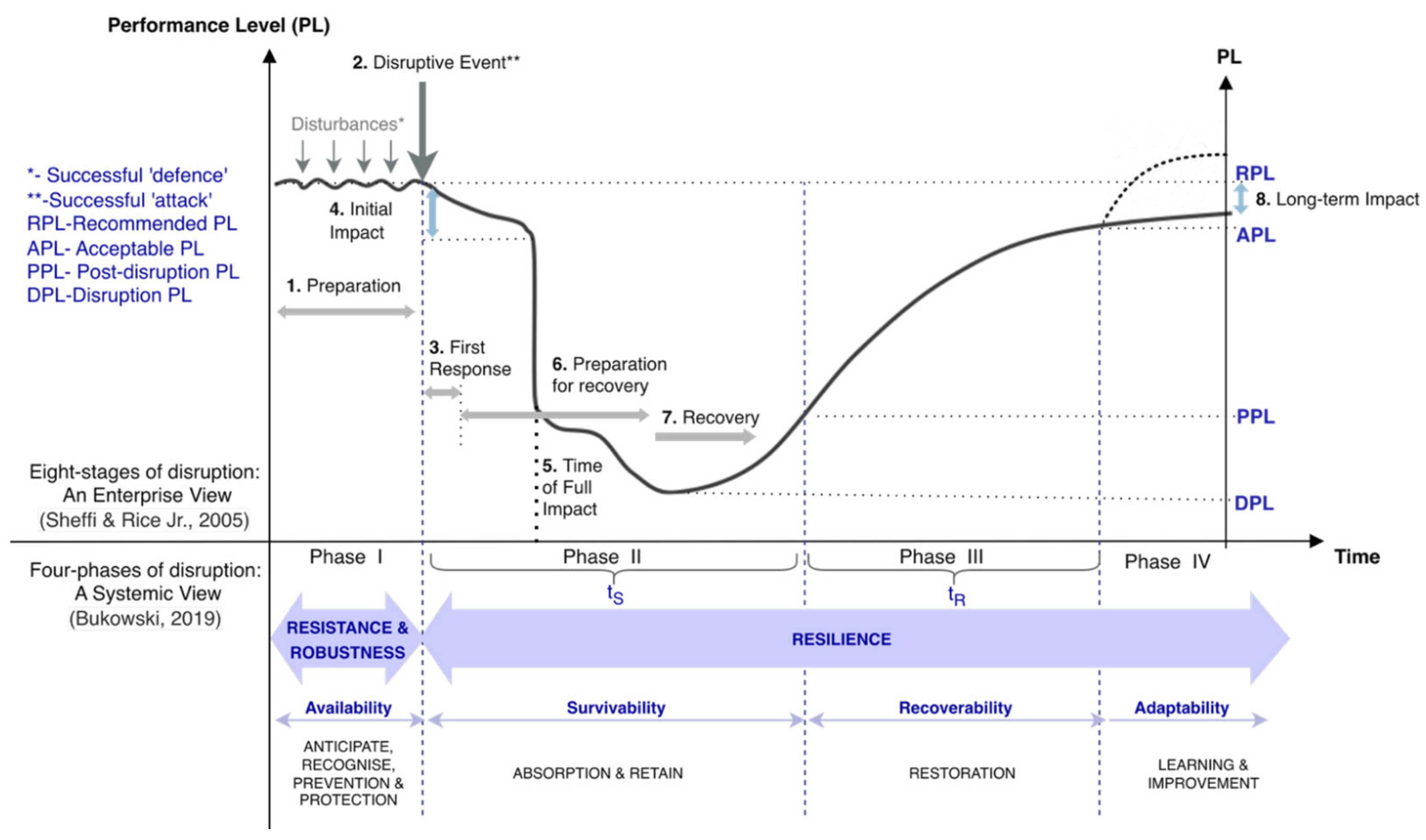
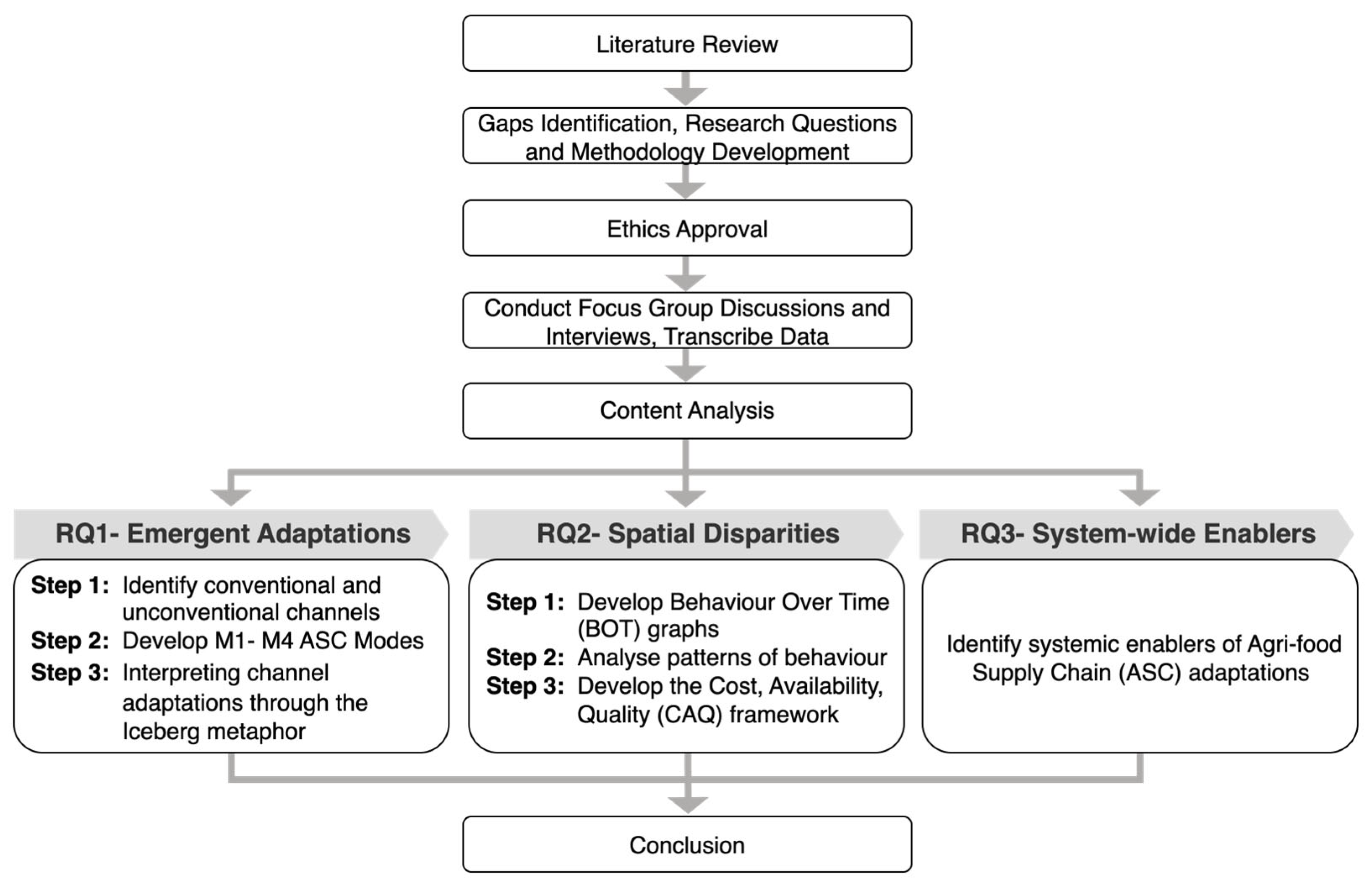
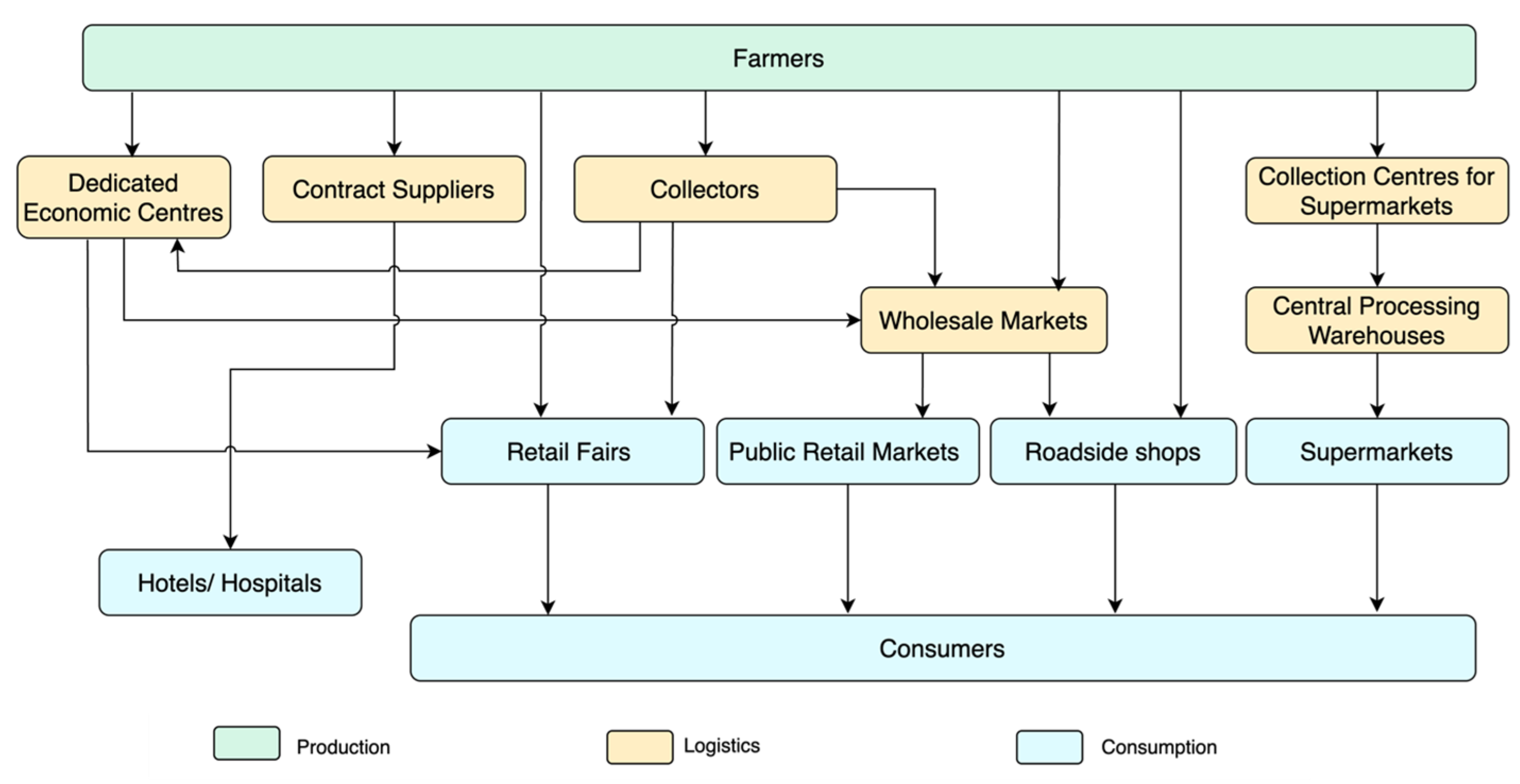
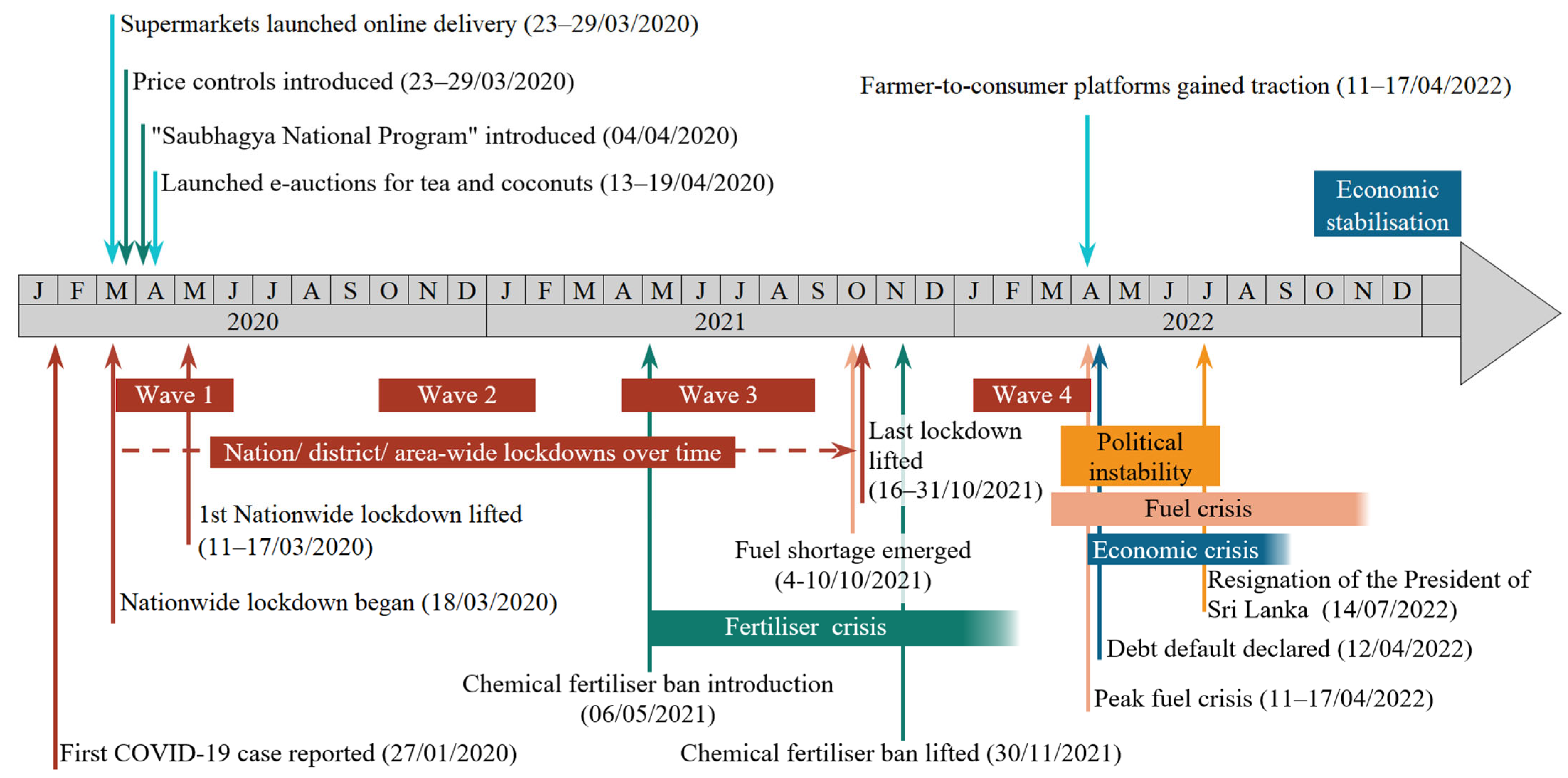

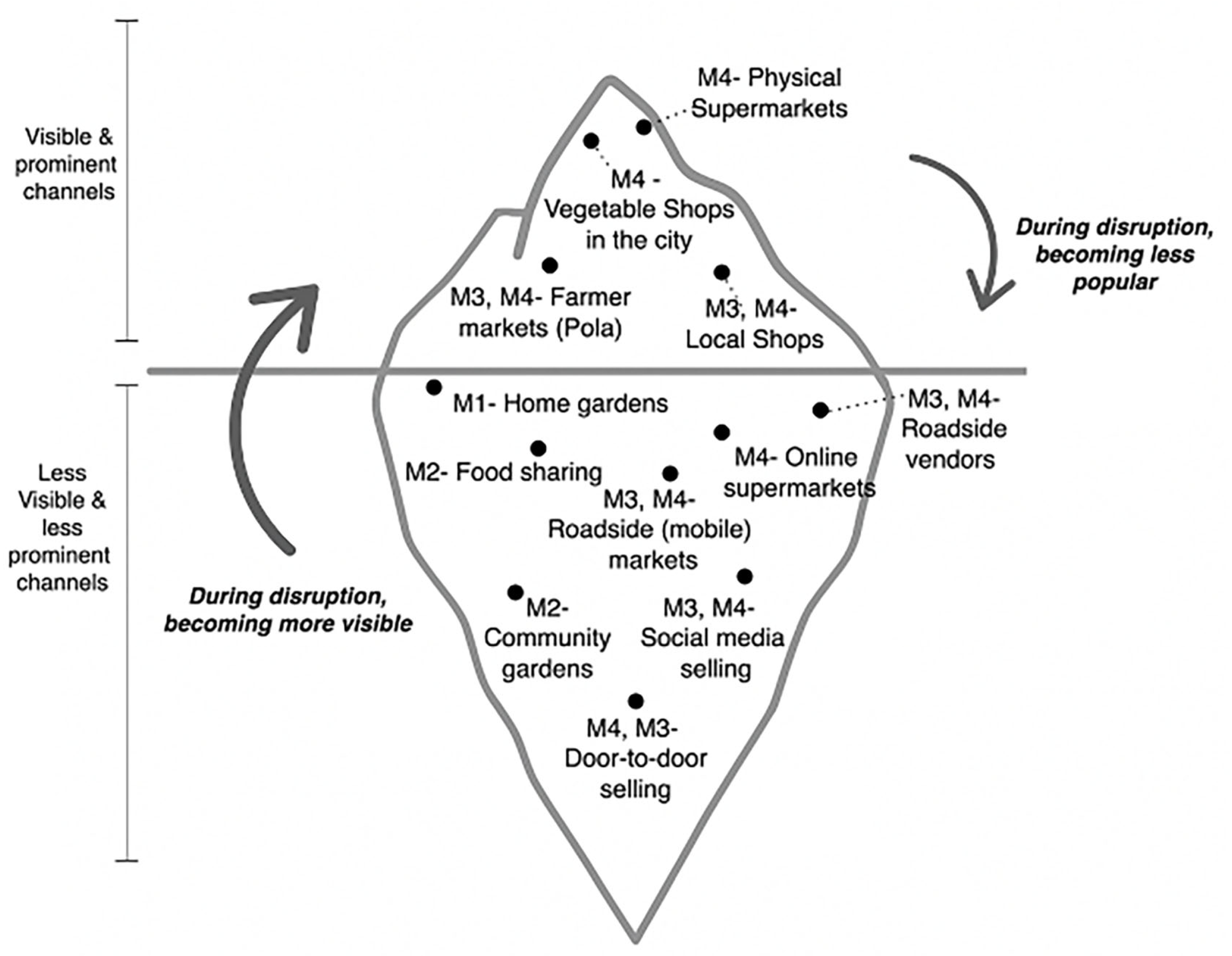
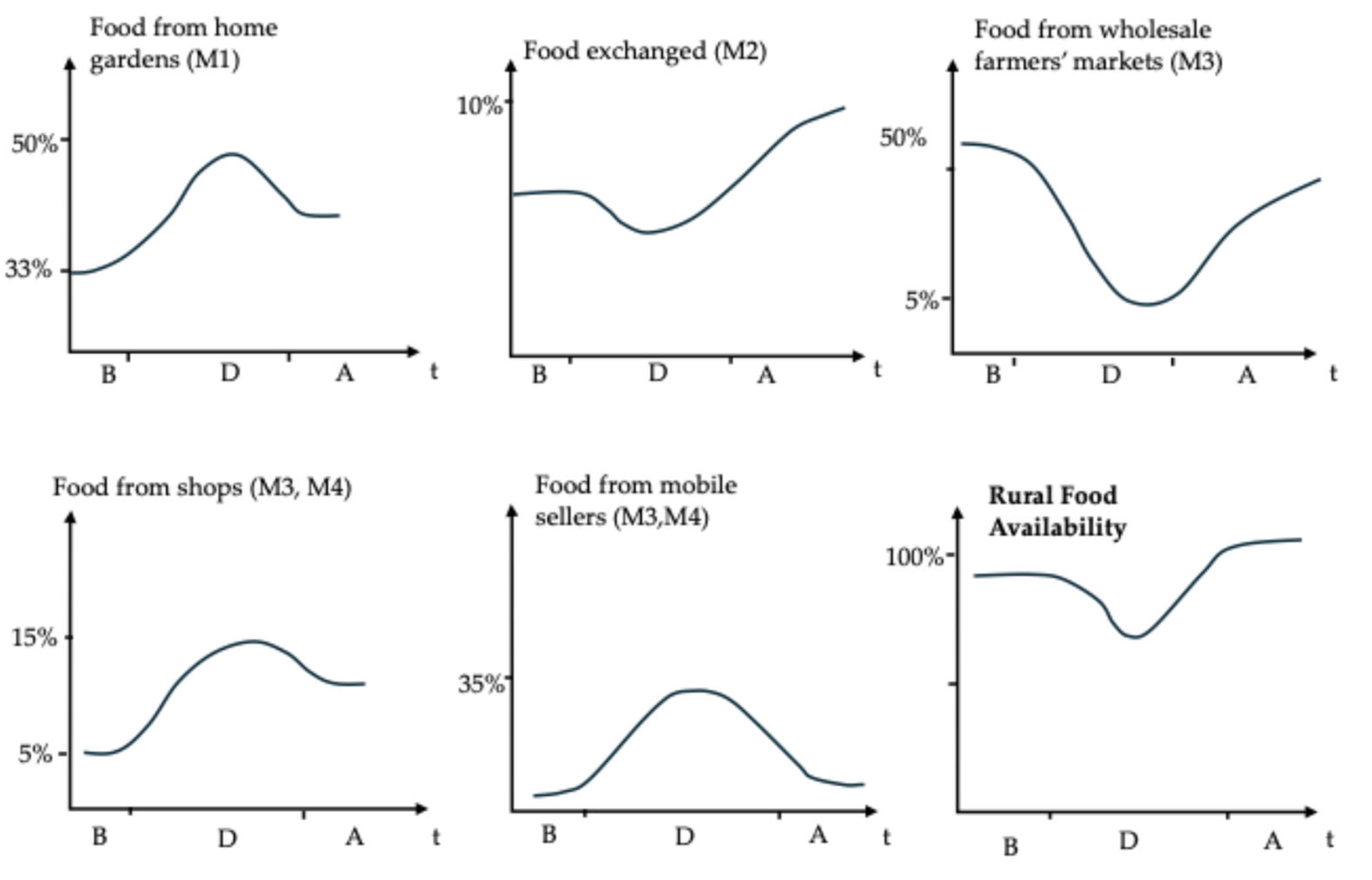
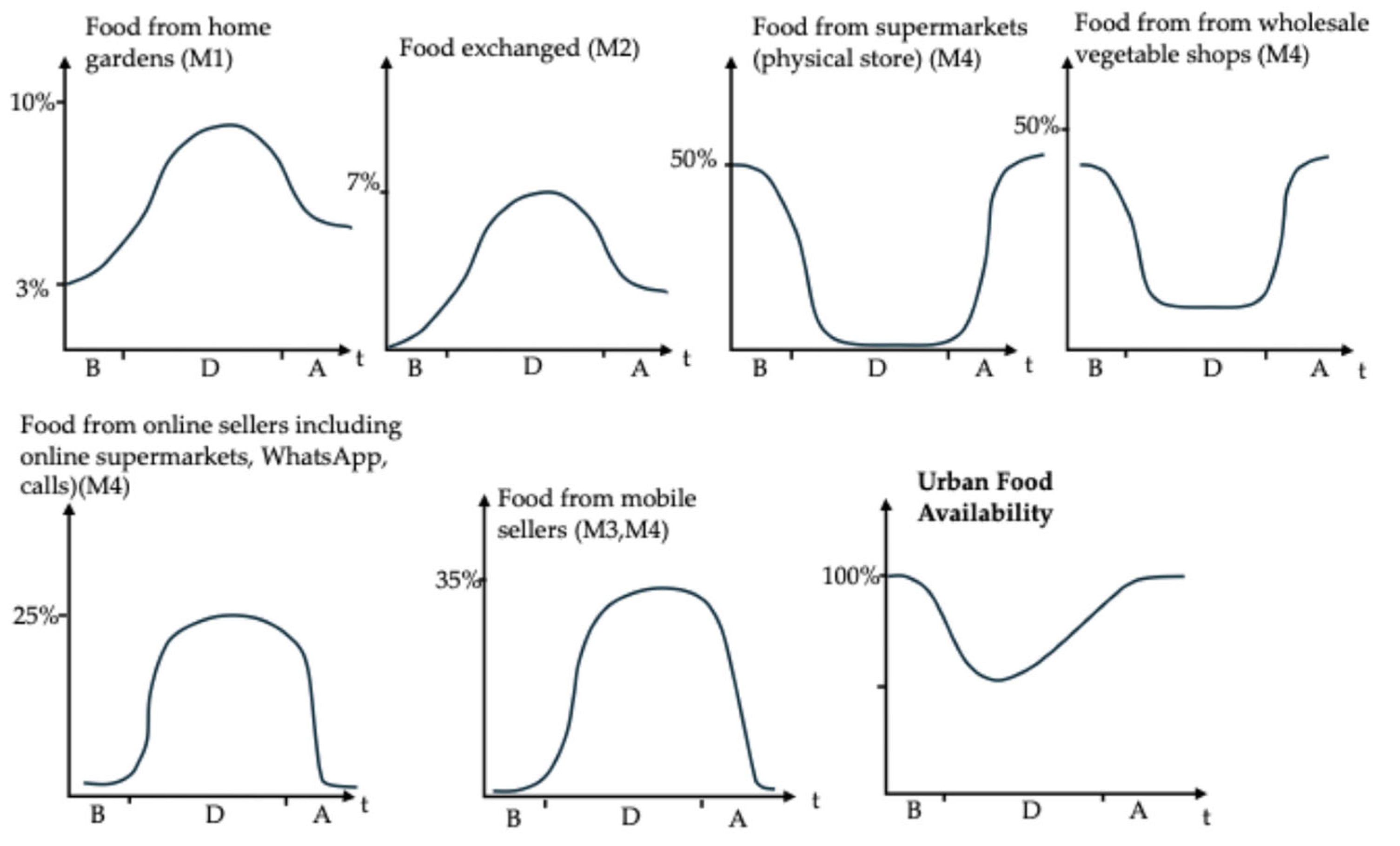

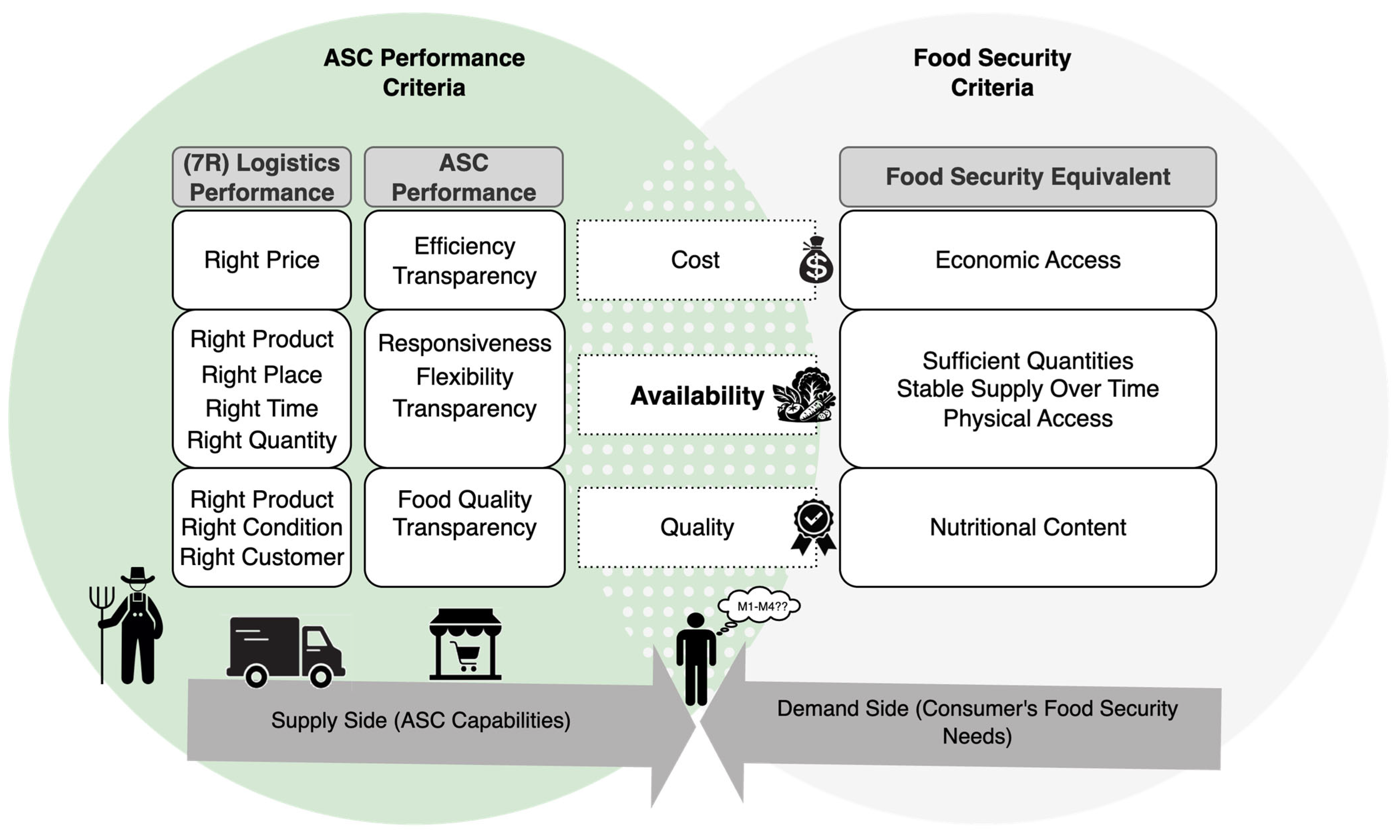

| Classification Basis | Classification | Description/Examples | ||
|---|---|---|---|---|
| By product type [20,21] | Fresh Products | Key characteristics include complex supply chains, perishability, and need for cold chains, e.g., fruits, and vegetables. | ||
| Processed Products | Canned foods and desserts. | |||
| By the degree of consumer engagement [22] | Minimal consumer engagement | Box schemes, farmers’ markets. | ||
| Collaborative models | Community-supported agriculture, consumer cooperatives, and participatory guarantee systems. | |||
| By the supply chain structure | Temporal arrangement [23] | Refers to the timing of different components in the supply chain. | ||
| Vertical stratification [23] | Describes the hierarchical levels of the various components. | |||
| Spatial arrangement | Refers to the geographical location and distribution of elements within the supply chain. | |||
| Long (Conventional) Food Supply Chains [24] [25] | Long food supply chains involve more intermediaries, leading to greater spatial distances between producers and consumers. | |||
| Short Food supply chains [25] | Face-to-face [25] | Supply chains, where consumers purchase directly from producers | ||
| Spatially proximate | Products are sold through local outlets in the area, and consumers are immediately aware of their local nature. | |||
| Spatially extended | Supply chains, such as those that export. | |||
| ASC Process Disrupted | Challenge | Initiatives/Recovery Strategies | Areas Impacted by Initiatives | |||
|---|---|---|---|---|---|---|
| Demand | Supply | Process | Structure | |||
| Farm production | Labour shortage; bottlenecks in other inputs | -Robotisation: information-driven independent choices in production. | x | x | ||
| Food processing | Food security and protection of employees | -Employees’ safety and health, change in working conditions: sanitisation, monitoring and screening the workers, cleaning and disinfecting the facilities, etc. -Additional food preparation facilities. | x | x | x | |
| Labour shortage, prevention of the transportation of microorganisms by people | -Efficiency improvement initiatives for physical distancing during production, such as robotisation. -Direct sales through digital platforms. -Selling meal kits rather than prepared food. | x | x | x | ||
| Logistics | Logistical barriers due to the lockdown | -Buyer chooses takeaway and home delivery because of social distancing and the shutdown of restaurants. -Click and collect method. -Linking farmers and restaurants directly to food banks. | x | x | x | |
| Collection and distribution of agri-food to consumers | -Urban distribution centres improve the effectiveness of the transportation and collection process. | x | x | |||
| To secure food delivery to people from weaker sections at a reasonable cost, especially the main ingredients | -The Public Distribution System (PDS) is used to access the weaker segments. | x | x | |||
| Demand | Enabling a quicker and adaptable joint effort among organisations and consumers | -Internet-based supply chain systems. | x | x | x | x |
| Production Adaptations | Logistics Adaptations | Consumption Adaptations |
|---|---|---|
| Strategy: Intertwining | ||
| -Public–private partnerships for home gardening campaigns in Sri Lanka, the Philippines, and Fiji [5]. -Collaboration between urban farmers and technology providers for smart agriculture solutions in Singapore [4]. | -Food hubs connecting local producers with consumers. -Virtual food hubs using digital platforms to link producers and consumers [7]. -Passenger logistics firms (Uber—India and Bykea—Pakistan) add food delivery services and maintain them afterwards [48]. | -Retailers liaising with friends and families to deliver food. -Social media communities sharing information about home gardening and food availability. -Consumers rely on neighbours and community groups for food support in Australia [30]. |
| Strategy: Substitution | ||
| -Singapore shifting from imported food to locally produced alternatives [4]. -Replacing traditional farming methods with vertical farming techniques in Singapore [4]. | -Shifting from supermarkets to local food hubs and farmers’ markets [7]. -Replacing traditional distribution channels with online platforms and delivery services [7]. | -Consumers shifting from supermarkets to local food sources and direct-from-farm purchases [30,50,53]. -Ordering fresh produce from online markets instead of physical stores [48]. |
| Strategy: Scalability | ||
| -Scaling up local food production through home gardening initiatives in Asian economies [5]. -Expanding vertical farming operations to meet growing urban food demand in Singapore [4]. | -Food hubs aggregating products from multiple producers to meet larger orders. -Virtual food hubs scaling operations to handle increased online orders. [7]. -Rapid delivery services like Getir in Turkey establishing divisions to assist small retailers with e-commerce applications and logistics for hyperlocal delivery [48]. | -Retailers expanding online presence and order processing capacity. -Supermarkets and farmer markets increasing delivery capabilities. |
| Strategy: Repurposing | ||
| -Repurposing urban spaces for urban farming initiatives in Singapore [4]. -Utilising digital technologies to facilitate home gardening and knowledge sharing in Malaysia [47]. | -Utilising existing infrastructure such as warehouses or community spaces for food hubs. -Adapting existing passenger transportation networks and logistics networks for food delivery services [3,7]. | -Using social media platforms for disseminating information about food availability and gardening tips. -Retailers adapting in-store pickup options for online orders. |
| Concept | Core Focus | Temporal Orientation | System Response |
|---|---|---|---|
| Resilience [36] | Withstanding and recovering from short-term shocks or disruptions. | Short- to medium-term | Bounce-back to pre-disruption state. |
| Adaptability [59] | Adjusting structure and behaviour in response to changing conditions. | Medium-term | Modify processes or relationships to cope with change. |
| Sustainability [60] | Maintaining environmental, social, and economic balance. | Long-term | Balance and continuity without compromising future capacity. |
| Viability [57] | Ensuring long-term survival through continuous adaptation and structural reconfiguration under dynamic conditions. | Cross-temporal (short, medium, and long-term) | Bounce-forward and evolve through systemic design and feedback learning. |
| Entity | Definition/Role |
|---|---|
| Collection centre | Small-scale facilities near farming areas where farmers drop off produce, often operated by traders, cooperatives, or supermarket chains. |
| Dedicated Economic Centre (DEC) | Large government-established wholesale markets act as aggregation hubs between producers and urban wholesalers and retailers. E.g., Dambulla DEC |
| Retail Fairs (Farmers’ Market) (Pola) | Periodic open-air markets where farmers or small vendors sell directly to consumers. These take place weekly or on specific days. In the local language, it is termed as “Pola”. These represent a form of short food supply chains, common in both rural and urban areas. |
| Public retail markets | Permanent, municipal-managed markets in towns and cities where consumers access a wide variety of produce and food items |
| Roadside shops/ Informal Vendors | Permanent, municipal-managed markets in towns and cities where consumers access a wide variety of produce and food items. Often supplied by wholesalers or intermediaries, not always by farmers. |
| Supermarkets’ collection centres | Large retail chains such as Cargills and Keells operate their own collection centres in production zones to gather and inspect produce before it reaches retail shelves. These centres are equipped with grading, packing, and cold chain facilities. After aggregation, the produce is transported to a central processing unit in Colombo and then distributed to supermarket outlets located primarily in urban areas. |
| Factors | Urban | Semi-Urban | Rural |
|---|---|---|---|
| Land area | Very small | Small | Large |
| Household income | High | Medium | Low |
| Distance to the closest supermarket (around) | <1 km | 1–5 km | >5 km |
| Number of supermarkets within 2 km radius | >5 | ~1 | ~0 |
| Number of grocery shops within 2 km radius | 10+ | 5+ | 1+ |
| Purchase from supermarkets | Very high | Medium | Extremely low |
| Direct purchasing from farmers | No | Unusual | Available |
| Home gardening | Low | Medium to high | High |
| Technology access | High | Medium to high | Low |
| Channel Category (Mode) | Representation of the Material Flow * | Type of Transaction | Key Transactions and Channel Examples | Implications of Cost, Availability and Quality |
|---|---|---|---|---|
| 1. Prosumer Mode (M1) | P→C | One-one | Consumers grow fresh agri-produce in home gardens and consume it directly, becoming both producers and consumers | Cost: Very low (self-produced); Availability: Limited to what can be cultivated; Quality: High freshness and trust, but limited diversity |
| 2. Community-based sharing Mode (M2) | P←→C | One-many Many-many Many-one | Individuals or communities grow or source fresh agri-produce and share it within their networks. This includes neighbour-to-neighbour exchanges, urban gardening groups, and organised community or NGO-based food-sharing initiatives. | Cost: Often free or very low (donation or exchange basis); Availability: Moderate, dependent on surplus and social networks; Quality: High, as produce is locally grown and minimally handled; |
| 3. Direct Farmer- Consumer Mode (M3) | P→(M)→C | Many-many | Consumers purchase directly from farmers through local markets, mobile vendors, or digital ordering systems. Farmers may use their own or shared logistics. | Cost: Lower than retail due to reduced intermediaries; Availability: Moderate, limited by production cycles and location; Quality: High, owing to freshness and reduced handling. |
| 4. Supply chains with intermediaries (M4) | P→I1→In→C | Many-many | Consumers buy fresh agri-produce that were grown by distant farmers from supermarkets/shops, where multiple intermediaries are involved in sourcing and supplying the produce to the supermarket, which then serves multiple consumers. | Cost: Higher due to intermediary margins and logistics costs; Availability: High, supported by large-scale networks; Quality: Variable: Standardised but may compromise freshness due to longer storage and transport. |
| Mode | Urban | Semi-Urban | Rural |
|---|---|---|---|
| M1. Prosumer (Home gardens) | Limited space; small scale; helped reduce Cost; boosted Quality; Availability constrained | Moderate adoption; space allowed more Availability; reduced Cost; good Quality | Core source; met all three (C, Q, A) with high self-sufficiency; scaled up during COVID |
| M2. Community Sharing | Minimal due to distancing; some social media-based exchanges; mainly Availability support | Stronger reliance; relatives and neighbours provided Cost-free Availability; Quality trusted | Very strong; ensured Availability; reduced Cost; maintained Quality through local trust |
| M3. Direct Farmer–Consumer (markets, roadside, mobile sellers) | Pre-COVID markets ensured Cost + Quality; during disruption shifted to mobile sellers for Availability | Pre-COVID mix (markets + shops); during COVID mobile sellers ensured Availability, with reasonable Cost/Quality | Farmers’ markets disrupted; adapted to mobile/local selling; supported Availability and Cost, variable Quality |
| M4. Intermediary Chains (supermarkets, shops, online) | Dominant pre-COVID (Cost, Quality); during COVID shifted online/WhatsApp for Availability; post-COVID hybrid with click and collect | Local shops central pre/during/post; provided balance of C, Q, A; supermarkets less trusted post-COVID (fertiliser issues) | Supplementary only; during COVID local shops filled gap for Availability; less important otherwise |
| Dimension | Logistics (7Rs) | ASC Performance | Food Security | Consumer Interpretation in Disruptive Times |
|---|---|---|---|---|
| Cost | Right Price | Efficiency Transparency | Economic access | Affordability of food under constrained budgets, accounting for rising prices, delivery fees, and inflation |
| Quality | Right Product Right Condition | Food quality Transparency | Nutritional content | Assurance of safe, fresh, and nutritious food despite reduced variety, compromised handling, or shorter shelf life |
| Availability | Right Product Right Place Right Time Right Quantity | Responsiveness Flexibility Transparency | Physical access Stable supply over time Sufficient quantities | Reliable access to enough food when and where needed, even under lockdowns, shortages, or transport breakdowns |
Disclaimer/Publisher’s Note: The statements, opinions and data contained in all publications are solely those of the individual author(s) and contributor(s) and not of MDPI and/or the editor(s). MDPI and/or the editor(s) disclaim responsibility for any injury to people or property resulting from any ideas, methods, instructions or products referred to in the content. |
© 2025 by the authors. Licensee MDPI, Basel, Switzerland. This article is an open access article distributed under the terms and conditions of the Creative Commons Attribution (CC BY) license (https://creativecommons.org/licenses/by/4.0/).
Share and Cite
Vidanagamachchi, K.; Ginige, A.; Nakandala, D. Viable Agri-Food Supply Chains: Survival Through Systemic Adaptations. Systems 2025, 13, 1056. https://doi.org/10.3390/systems13121056
Vidanagamachchi K, Ginige A, Nakandala D. Viable Agri-Food Supply Chains: Survival Through Systemic Adaptations. Systems. 2025; 13(12):1056. https://doi.org/10.3390/systems13121056
Chicago/Turabian StyleVidanagamachchi, Kasuni, Athula Ginige, and Dilupa Nakandala. 2025. "Viable Agri-Food Supply Chains: Survival Through Systemic Adaptations" Systems 13, no. 12: 1056. https://doi.org/10.3390/systems13121056
APA StyleVidanagamachchi, K., Ginige, A., & Nakandala, D. (2025). Viable Agri-Food Supply Chains: Survival Through Systemic Adaptations. Systems, 13(12), 1056. https://doi.org/10.3390/systems13121056







